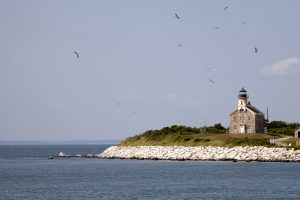FOR IMMEDIATE RELEASE
August 10, 2018
Contact: Laura McMillan, 203-787-0646
Feds postpone Plum Island sale, plan new environmental study; CFE/Save the Sound responds to win for Endangered Species Act and pledges continued advocacy
New Haven, Conn. – The U.S. General Services Administration (GSA) announced today that it intends to prepare a Supplemental Environmental Impact Statement (SEIS) for the sale of Plum Island, New York. The scoping process will likely begin next year, and the new statement will result in a new record of decision that supersedes the decision issued in 2013. The agencies also stated that they anticipate addressing requirements of the Endangered Species Act and the Coastal Zone Management Act. Any sale of the island would now occur no earlier than 2023, they predict.

Connecticut Fund for the Environment/Save the Sound and six other organizations and individuals filed suit against GSA and the Department of Homeland Security in July 2016. The suit argues that the original Final Environmental Impact Statement was insufficient and that the agencies violated provisions of the National Environmental Protection Act (which governs the Environmental Impact Statement process), Endangered Species Act, Coastal Zone Management Act, and other federal laws by failing to adequately consider the environmental impact of such a sale.
“We are extremely pleased that the GSA and Homeland Security have recognized their legal obligations under the Endangered Species Act and Coastal Zone Management Act, and that they are now prepared to remedy the radical deficiencies in their Environmental Impact Statement that we outlined in our lawsuit,” said Roger Reynolds, chief legal officer for CFE/Save the Sound. “That being said, they have not indicated any intent to fix the biggest problem: the Environmental Impact Statement’s outright failure to even consider conservation or a conservation sale as an alternative. Since there is no reason to think they intend to remedy this glaring and fundamental flaw, we will continue to advocate strongly for relief and permanent conservation of this irreplaceable land.”
In addition to CFE/Save the Sound, the suit was brought by Soundkeeper, Inc., Peconic Baykeeper, Group for the East End, Ruth Ann Bramson, John Potter, and John Turner. Morrison & Foerster LLP is representing the plaintiffs.
Homeland Security and GSA served a motion to dismiss the suit in February 2017. In January 2018, Judge Denis Hurley of the Eastern District of New York found that the plaintiffs have standing and rejected each of the agencies’ arguments. The lawsuit was scheduled to be briefed in November 2018. It is not yet known how today’s announcement will affect that schedule.
The SEIS will document changing conditions and new information since the publication of the original environmental statement and decision, the GSA said. Among these are the four-season biological inventory known as the “Biodiversity and Ecological Potential of Plum Island, New York;” activities undertaken by the U.S. Fish and Wildlife Service; the Town of Southold’s 2013 zoning plan for Plum Island; a Conceptual Site Model by DHS; ongoing environmental remediation by DHS, Army Corps of Engineers activities under the Formerly Used Defense Site program, and progress by DHS under the National Historic Preservation Act. The SEIS will identify potentially significant direct, indirect, and cumulative impacts on historical and biological resources, land use, air quality, water quality, water resources, and socioeconomics, as well as other environmental issues that could occur as a result of the proposed action. The SEIS may identify measures to avoid, minimize, or mitigate potentially major impacts where feasible, the agencies said. Once published, the SEIS will supersede the FEIS and ROD issued in 2013. The agencies also anticipate addressing the Federal Consistency Review process under the Coastal Zone Management Act and applicable requirements of the Endangered Species Act.
Plum Island, an 840-acre island in the eastern end of Long Island Sound, provides habitat for several federally endangered and threatened species of flora and fauna including roseate Tern and Piping Plover. The waters surrounding it are home to federally listed marine species such as Atlantic hawksbill sea turtles, Kemps Ridley sea turtles, and Atlantic Sturgeon, and it’s home to the largest seal haul-out area in southern new England.
For over half a decade it has been the subject of a massive conservation effort by the Preserve Plum Island Coalition (now numbering over 100 Connecticut, New York, and Rhode Island organizations), grassroots activists, and champions in Congress on both sides of the aisle. The U.S. Environmental Protection Agency has noted that the original FEIS failed to consider an ordinance to create a conservation area to limit development and preserve “much of the island,” and did not offer options that EPA had recommended to mitigate environmental damage.
###
The mission of Connecticut Fund for the Environment and its bi-state program Save the Sound is to protect and improve the land, air, and water of Connecticut and Long Island Sound. We use legal and scientific expertise and bring citizens together to achieve results that benefit our environment for current and future generations. About CFE/Save the Sound
